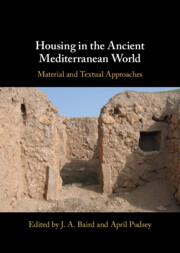Book contents
- Housing in the Ancient Mediterranean World
- Housing in the Ancient Mediterranean World
- Copyright page
- Contents
- Figures
- Tables
- Contributors
- Acknowledgements
- Introduction
- 1 Kinship ‘In the Halls’
- 2 Domesticating the Ancient House
- 3 Mind the Gap
- 4 A Family Affair
- 5 Textiles in Alkestis’ thalamos
- 6 Architectural Rhetoric and the Rhetoric of Architecture
- 7 The Reconstruction of an Agricultural Landscape
- 8 Mudbricks and Papyri from the Desert Sand
- 9 Housing and Community
- 10 The Elusive vestibulum
- 11 Living in the Liminal
- 12 Experiencing Sense, Place and Space in the Roman Villa
- 13 Houses and Time
- 14 Spaces of Desire
- 15 A Response: ‘Using the Material and Written Sources’ Revisited
- Index
- References
1 - Kinship ‘In the Halls’
Poetry and the Archaeology of Early Greek Housing
Published online by Cambridge University Press: 08 July 2022
- Housing in the Ancient Mediterranean World
- Housing in the Ancient Mediterranean World
- Copyright page
- Contents
- Figures
- Tables
- Contributors
- Acknowledgements
- Introduction
- 1 Kinship ‘In the Halls’
- 2 Domesticating the Ancient House
- 3 Mind the Gap
- 4 A Family Affair
- 5 Textiles in Alkestis’ thalamos
- 6 Architectural Rhetoric and the Rhetoric of Architecture
- 7 The Reconstruction of an Agricultural Landscape
- 8 Mudbricks and Papyri from the Desert Sand
- 9 Housing and Community
- 10 The Elusive vestibulum
- 11 Living in the Liminal
- 12 Experiencing Sense, Place and Space in the Roman Villa
- 13 Houses and Time
- 14 Spaces of Desire
- 15 A Response: ‘Using the Material and Written Sources’ Revisited
- Index
- References
Summary
Scholarship on Early Greek housing has moved from creating fictional reconstructions based on Homeric poetry, through typological sorting of archaeological houses by shape and rooms, to analysing access patterns and functionalization. These more recent approaches have largely estranged epic poetry from archaeology. However, since they seek to understand domestic structures as experienced by living people, there is a way to build poetry back in by using it to explore the ways their inhabitants thought about domestic spaces. The phrase ‘in the halls’ is used abundantly in the Homeric and Hesiodic corpus as a metonymy for familial life and prosperity. The phrase should be read not as a reality to be sought in the archaeological record but abstractly as an indicator of the importance of physical space in a household’s formation and success. The link between prosperity, family and house can also be seen in the renovations and increasing complexities in some early Greek domestic architecture. Success and wealth modify and are expressed in the house. ‘In the halls’ thus refers to an important cultural idea, also seen in archaeology, linking house, home and family with prosperity.
- Type
- Chapter
- Information
- Housing in the Ancient Mediterranean WorldMaterial and Textual Approaches, pp. 27 - 67Publisher: Cambridge University PressPrint publication year: 2022



